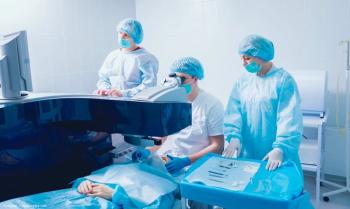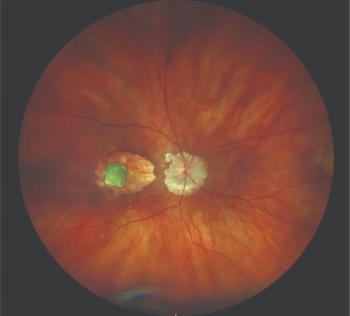
Supraciliary micro-stent reduces IOP and medication burden
Efficacy is achieved with a favorable safety profile in 1-year study data
TAKE-HOME
A supraciliary micro-stent (CyPass Micro-Stent, Transcend Medical) reduces IOP and medication use in eyes with uncontrolled IOP and medication burden in eyes with medically-controlled IOP.
By Cheryl Guttman Krader; Reviewed by Quang H. Nguyen, MD
La Jolla, CA-Implantation of a supraciliary micro-stent reduces IOP and medication burden.
Results from a prospective, international, interventional study show that the investigational supraciliary micro-stent (CyPass Micro-Stent, Transcend Medical) is a safe and effective stand-alone treatment for patients with primary open-angle glaucoma, said Quang H. Nguyen, MD, investigator in the multicenter study and director of the Glaucoma Service at Scripps Clinic in La Jolla, CA.
The micro-stent procedure results in a controlled cyclodialysis and creates a permanent conduit between the anterior chamber and suprachoroidal space to increase non-trabecular aqueous outflow. The device is constructed of a non-degradable, biocompatible polyimide material. It is 6.35 mm in length, has an external diameter of 510 µm, and a 300-µm internal lumen. It is inserted into the supraciliary space using a guidewire. Goniolens-free insertion is feasible.
Clinical experience study
Dr. Nguyen presented outcomes from follow-up at 6 and 12 months for patients in the CyPass Clinical Experience (CyCLE) study who underwent the minimally invasive glaucoma procedure surgery without combined phacoemulsification. The patients in this arm of the study represented two subgroups comprising 134 eyes with uncontrolled IOP (≥21 mm Hg at baseline, Group 1) and 88 eyes with IOP controlled on medications (Group 2).
Group 1 eyes achieved a 26% reduction in IOP with a 33% decrease in average medication use, while IOP remained stable in Group 2 but with a 40% reduction in daily medication need. These results were achieved without any of the dreaded complications associated with filtering surgery, Dr. Nguyen noted.
“The micro-stent needed to be explanted in 1 eye and repositioned in 1 eye, but there were no cases of hypotony maculopathy, suprachoroidal hemorrhage, retinal detachment, iris atrophy, or endophthalmitis,” he said.
“Nearly 11% of eyes needed additional surgical intervention for glaucoma, but the beauty of this procedure is that it is an ab interno approach performed through a 1.5 mm clear cornea incision,” Dr. Nguyen added. “The surgery does not disturb the conjunctiva, and so it does not preclude other surgical procedures that may be needed in the future for IOP control.”
The 222 patients who underwent the micro-stent implantation as a stand-alone procedure had a mean age of close to 70 years and were equally represented by males and females; 43% of eyes had undergone prior surgery for IOP lowering, including more than 20% who had undergone previous trabeculectomy or tube surgery.
Mean IOP in Group 1 was 27.4 mm Hg at baseline. At 6 months, when 71 eyes were available for follow-up, mean IOP was 18.3 mm Hg, and it remained stable at 18.9 mm Hg in the 27 eyes seen at 1 year. Mean medication use was reduced from 2.4 at baseline to 1.6 at 1 year.
In Group 2, mean baseline IOP was 17.9 mm Hg. Data from 6 months was available for 57 eyes and showed mean IOP was 16.2 mm Hg. At 1 year, 37 eyes were seen, and their mean IOP was 16.5 mm Hg. The stable IOP was achieved with a decrease in average medication use from 2.3 to 1.4.
The most common complication encountered in the study population was IOP increase persisting longer than 1 month (7.9%) followed by device obstruction (3.6%) and transient hyphema (lasting <1 month, 2.7%). Transient inflammation, anterior chamber shallowing, and endothelial touch each occurred at a rate of 1.8%, transient hypotony lasting more than 1 month occurred in 1.3% of eyes, and there was a 0.4% rate of best-corrected visual acuity loss.
Quang H. Nguyen, MD
Dr. Nguyen is a consultant to Transcend Medical. This article is adapted from Dr. Nguyen’s presentation at the annual meeting of the American Academy of Ophthalmology.
Newsletter
Don’t miss out—get Ophthalmology Times updates on the latest clinical advancements and expert interviews, straight to your inbox.





